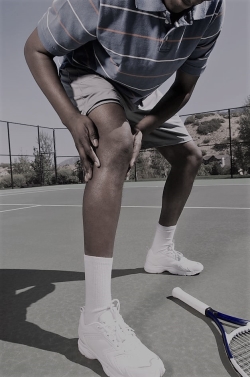 Millions of Americans and their loved ones are intimately familiar with
arthritis – the inflammation, swelling and stiffness that can take
our once limber joints hostage at any time and cause them debilitating
pain and immobility.
Osteoarthritis, sometimes referred to as "degenerative joint disease" or "wear
and tear" arthritis, is one of the most common types, and as the
name suggests, it's caused by the breakdown of the cartilage that
cushions the joints.
Millions of Americans and their loved ones are intimately familiar with
arthritis – the inflammation, swelling and stiffness that can take
our once limber joints hostage at any time and cause them debilitating
pain and immobility.
Osteoarthritis, sometimes referred to as "degenerative joint disease" or "wear
and tear" arthritis, is one of the most common types, and as the
name suggests, it's caused by the breakdown of the cartilage that
cushions the joints.
Though osteoarthritis can affect any joint in the body (fingers and hips are some usual targets), another common spot is the knee. Because we use our knees for most daily living activities, the most basic being walking, having a flare up of knee arthritis can make it hard to get through a day. While there is no cure for this condition, there are a variety of options to help manage the pain and stay active.
I understand that staying active with knee arthritis pain may sound like an oxymoron. When inflammation and stiffness are most severe, it can seem nearly impossible to move more than necessary, let alone cruise around on a bicycle. Believe it or not, however, exercise is not only possible for people with knee arthritis, but crucial. The thought of getting up and being active may seem overwhelming, but consider these reasons to do so: How to Practice Yoga When You Have Arthritis or Another Chronic Condition .
First, it's proven that people with arthritis who exercise regularly have less pain. Concerned that exercising will stress your joints more and make the knee pain and stiffness worse? Research suggests that exercise has the opposite effect. In fact, exercise is considered the most effective non-drug treatment available for reducing pain, while improving range of motion and quality of life. Plus, it can give your energy levels a boost and help you sleep more soundly, and you'll likely begin to see your function levels rise. So how exactly does moving more help soothe sore knees and other joints? Well, when you're active and exercising, your muscles and tissues surrounding the joints are being strengthened – and the stronger they are, the more support they can provide for the bones and joints. Not exercising weakens those surrounding muscles, adding to the stress on the joints, and often results in the arthritis pain becoming worse over time.
As with any exercise regimen, it's imperative to clear it with your doctor first and to start off slowly with a few low-impact activities to gauge your fitness level and ensure you don't go too hard too quickly, which can lead to injuries. Once you get going, there are three different types of exercises people with arthritis should include in their routine for maximum effect in a step-wise progression. They are:
Range of motion and flexibility. These exercises can (and should) be done daily and are designed to take your joints through their full range of motion to maintain that movement and become more flexible. Basic stretching is a great ROM exercise and can be as simple as gently flexing and extending your knee repeatedly throughout the day.
Strengthening. This type of movement will help build up the muscle strength in the quads and hamstrings surrounding the knee joints so they're better protected and supported. Weight lifting just two days a week is all that's necessary to maintain muscle strength, and three days a week will help build even more. Remember to always stretch before and after lifting weights, and unlike range of motion exercises, give yourself a one-day break in between weight lifting sessions.
Aerobic. This endurance type of exercise will strengthen your heart and facilitate overall body fitness. Elevating your heart rate by walking, jogging, biking or swimming will get those calories burning, can help you to shed pounds if you have extra to lose (which will remove some stress on the knee joints), boost your daytime energy and help you sleep better at night. That's quite a lot of benefit from just 20 minutes a day. Aerobic exercise is safe to do every day, but you can start at just a few days and work your way progressively up as your stamina improves.
If fatigue becomes a problem as you're doing these exercises, simply break them up into shorter 10-minute sessions throughout the day, instead of trying to finish it all at once. The point is not to you work yourself into exhaustion, but that your knee joint is getting consistent appropriate movement. Don't forget that your regular daily activities still amount to "exercise," too. Taking the dog for a walk or moving the lawn? Yep, those count.
Remember: Motion is life, and life is motion. To anyone with arthritis, especially of the knee, getting the right kinds of exercise daily is vital to your health. It sounds contradictory, but movement and exercise will ultimately free you from the chains of immobility that arthritis can put you in. It's possible to live the active life you've always wanted to, even with arthritis. Set a goal for yourself, make an action plan and watch the knee pain slowly ease away.
